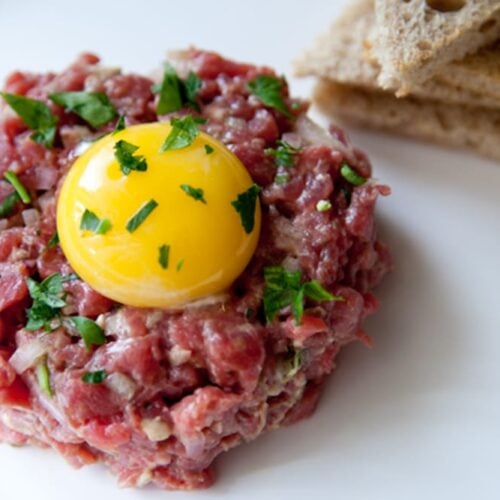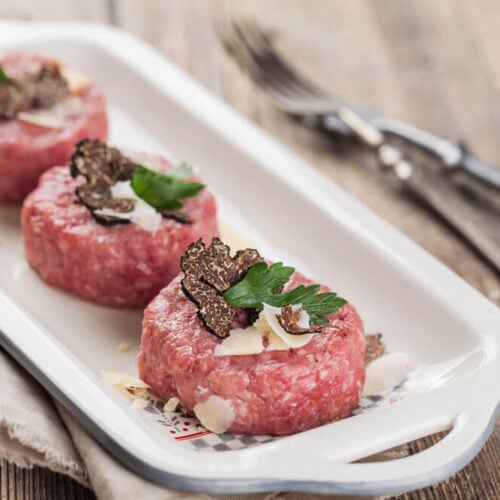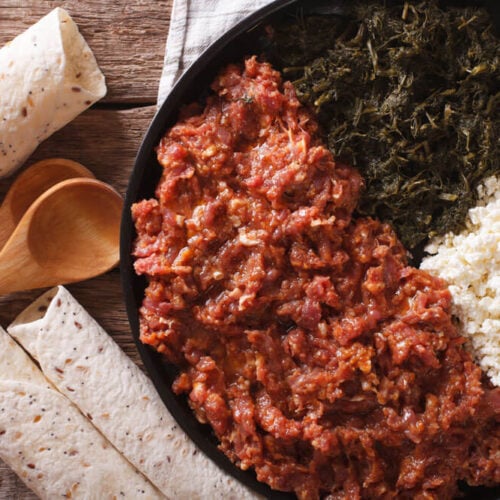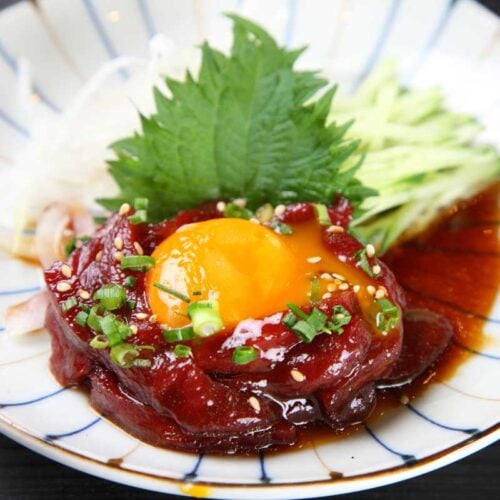Almost all cultures that eat traditional whole food diets have recipes for raw meat, and trying these dishes can really give you a unique and exciting taste of the culture itself.
Everyone should try well-prepared raw beef once, even if you think you won’t like it, as it can be a surprising treat. Here are five traditional raw beef recipes from different parts of the world.
The Benefits of Raw Animal Foods
Fresh, local, organic foods in their raw or fermented state are nutrient-dense and packed with enzymes and beneficial bacteria that help us absorb vitamins and maintain a healthy digestive system. You might be surprised that this is especially true of raw, pasture-raised meats, eggs and dairy, as well as wild caught seafood.
Heating animal foods denatures their fat and protein, destroys their enzymes and reduces their vitamin content. For example, people who are lactose-intolerant to pasteurized dairy often have no problem with raw milk, which has its lactase enzyme intact to break down the lactose naturally.
Properly prepared raw meat is very easy to digest. Raw meat also has significantly more vitamins than cooked meat and contains enzymes for digestion. Raw beef, when from a healthy, pasture-raised, grass-fed cow, is packed with Vitamins A, D and B-12 as well as iron, selenium, zinc and magnesium, which most Americans have deficiencies in.
Grass-fed beef also is very high in Omega-3 fatty acids and is the highest food source of cancer-fighting Conjugated Linoleic Acid (CLA).
But, when you grill meat, sear it, or cook it to temperatures above medium rare, you not only destroy nutrients, but you can also create oxidized fats and chemical byproducts that can be highly toxic to the body if eaten frequently. Some of these byproducts, like the char on blackened meat and fish, are carcinogenic.

Long ago, charred meat was probably one of the few environmental toxins we ever unknowingly introduced into our lives. But today, given how polluted our living environments have become, how stressed out our modern lives are, and how depleted most of our food is to begin with, adding to your body’s toxic burden by eating a lot of foods that have been ultra-pasteurized, irradiated, microwaved or cooked too long at high temperatures is just not a very good idea.
Eating at least a third of your food in a raw or lacto-fermented state can greatly improve your digestion and nutrition, and therefore your health! Here are some raw or lacto-fermented foods you might include more in your diet:
- vegetable salads
- sushi or sashimi
- raw milk or raw milk cheese
- yogurt or kefir with active cultures
- salami, carpaccio or pastrami
- sauerkraut and other fermented vegetables
- beef or tuna tartare
- ceviche or poke
- raw egg smoothies
- green smoothies
- raw egg and raw milk ice cream
- frozen raw liver “pills”
Selecting Safe Raw Animal Foods
Raw meat or seafood marinated in acid (citrus, vinegar, etc.) and seasoned with local spices is an ancient and traditional way of preparing meat that goes by many names, and is enjoyed by many people worldwide.
However, the quality of the ingredients is paramount to the success of the dish, and, considering the horrid infections that occasionally strike those who eat industrially-raised, feedlot meats, selecting your meat properly is very important.
To eat any raw food safely (plant or animal), always make sure it is fresh, organic, and preferably raised on a local, small farm you can visit or vet in some way to make sure the animals are clean and healthy.
Any animal products you intend to eat raw must not only be organic, but also pasture-raised and grass-fed. Anything else just isn’t as likely to be safe or healthy.
While industrially-produced, grain-fed animal products from the grocery store are typically not clean enough to consume raw, you can often find eggs, meat, seafood and dairy that are fresh, toxin-free and pasture-raised from local farmers (or wild-caught by local fishermen).
Other good places to find clean meat are natural food stores, good butcher shops, Eatwild.com, or through reputable online retailers like U.S. Wellness Meats and Vital Choice Seafood.
Selecting and Handling Raw Beef
Choose your beef from healthy, 100% pasture-raised cattle that are not treated with hormones or antibiotics. If the beef has also been flash-frozen immediately after butchering, you can feel extra comfortable eating it raw. (U.S. Wellness Meats does this.)
To eat fresh raw beef safely, you want to find a thick, whole piece of grass-fed beef filet or sirloin. Filet or sirloin are the most tender cuts, and you want the cut to be thick because the bacteria that can cause food poisoning can’t penetrate a whole piece of meat—they stay on the surface.
When you get the meat home, quickly sear it on all sides—you’re just killing whatever is on the surface, not cooking the meat. Then remove it from the flames, trim away the seared sections, and you’re ready to proceed.

Steak Tartare – France
Ingredients
- 2 lbs. grass-fed sirloin, (choice or prime)
- 2 Tbsp. capers
- 1 small onion, chopped
- 2 egg yolks, preferably from organic, pasture-raised eggs
- 2 Tbsp. extra virgin olive oil
- sea salt, to taste
- ground black pepper, to taste
- 6 wild-caught anchovy filets, minced
- wheat-free Worcestershire sauce, to taste
- 1 dash Tabasco, or other hot sauce
- 1 Tbsp. red wine vinegar
- 1/4 cup parsley, chopped
- 1/2 tsp. Dijon mustard
Instructions
- Chop the meat very finely with a sharp, long-bladed knife. Don’t use a grinder because the texture will suffer.
- Mix ingredients carefully to maintain fluffiness.
- Shape into a large loaf.
- Garnish with anchovy strips, more onions, more capers.
- Enjoy with toast points or any kind of cracker.
Nutrition

Carne Cruda – Italy
Ingredients
- 1 lb. grass-fed beef filet
- 2 lemons, juiced
- 2 cloves garlic, crushed flat (or more, to taste)
- sea salt, to taste
- ground black pepper, to taste
- 1 white truffle, (OPTIONAL)
- 1 wild-caught anchovy filet, rinsed, boned and minced (OPTIONAL)
Instructions
- Chop the meat very finely with a sharp, long-bladed knife. Don’t use a grinder because the texture will suffer.
- Put the meat in a bowl and mix the lemon juice into it, together with the garlic, and season abundantly with olive oil (as much as the lemon juice or perhaps more), salt and pepper. If you are using the anchovy, add it now.
- Let the meat sit, for between 10 minutes and two hours—the longer it sits the more the pinkness will fade, as the lemon juice cooks the meat.
- Once it has sat, mix it again, removing the flattened garlic chunks when you do.
- Put it on a serving dish, and garnish it with finely shaved truffle if you’re using it, and serve it as an antipasto or appetizer.
Nutrition

Kitfo – Ethiopia
Ingredients
- 2 lbs. grass-fed top round or sirloin
- 6 tsp. Mitmita, (or use ground cayenne pepper)
- 4 Tbsp. grass-fed ghee
- 1 tsp. cardamom
- 1/4 tsp. garlic powder, (optional)
- sea salt, to taste
- ground black pepper, to taste
Instructions
- Cut the meat into small pieces; remove fat and sinews.
- In a food processor put small amount of the meat at a time, sprinkle on some Mitmita or cayenne, process until meat is finely chopped. Alternately, you can mince the meat very fine with knives.
- Using a fork, remove any fat or sinews from the minced, spiced meat; repeat the process until all the meat is done
- In small pot, melt the clarified butter or ghee over low heat, mix in the remaining Mitmita or cayenne, cardamom, garlic, black pepper, and sea salt; remove from heat.
- Combine the spicy ground meat with the spicy butter, and mix thoroughly until the meat is completely marinated.
- If preferred, sauté the marinated meat for one or two minutes.
- Enjoy immediately with Injera or bread.
Nutrition

Beef Larb – Thailand
Ingredients
- 1 lb. grass-fed sirloin
- 1 Tbsp. Jasmine rice, uncooked
- 3-5 shallots
- 1 bunch fresh cilantro
- 1 bunch mint
- 4-6 red bird’s eye chili peppers, de-seeded
- 3 makrut (Thai) lime leaves
- ¾ Tbsp. Asian fish sauce
- ½ lime
- sea salt , to taste
- lettuce leaves, for serving
Instructions
- Toast the rice in a dry skillet, shaking occasionally, until golden and fragrant.
- Grind toasted rice to a fine powder in a mortar and pestle or spice grinder.
- Chop the meat very finely with a sharp, long-bladed knife. Don’t use a grinder, because the texture will suffer.
- Mince the shallots, herbs, chilies and lime leaves.
- Combine all ingredients, and season with fish sauce and lime juice.
- Taste and adjust seasonings.
- Wrap the larb in lettuce leaves, and enjoy!
Nutrition

Yukhoe – Korea
Ingredients
- 8 ounces grass-fed beef filet, or choose any tender cut of beef without fat: flank steak, tenderloin, round, etc.
- ½ Korean pear, or 2 bosc or anjou pears
- 1 Tbsp. raw cane sugar
- 2 cups filtered water
- 4-5 cloves garlic , crushed or minced
- ½ green onion, minced
- 1 Tbsp. coconut aminos, or gluten free soy sauce (Don't use low sodium for this dish!)
- 1 Tbsp. raw honey, or sugar
- 2 Tbsps. toasted sesame oil
- 1 pinch ground black pepper
- 1 Tbsp. sesame seeds, toasted
- 7-8 pine nuts
- 1 egg yolk, (OPTIONAL)
Instructions
- Freeze the beef for 1 to 2 hours, so it is easier to cut, and very cold when it goes into the seasoning sauce. Try not to handle the meat too much as you cut it, so it stays cold.
- Combine garlic, green onion, aminos/soy sauce, honey, ground black pepper, toasted sesame oil, and sesame seeds in a bowl, and mix very well.
- In a separate bowl, mix 2 cups of cold water and 1 tablespoon sugar until dissolved.
- Peel the pear and cut it into matchsticks. Soak them in the sugar water for about 10 minutes.
- Drain the pear sticks and dry with a paper or lint-free cloth towel. Arrange them on a plate like a nest, leaving a spot in the center or to the side to put the yukhoe.
- Remove beef from the freezer and rinse it in cold running water. Pat dry with paper or lint-free cloth towels.
- Cut the beef into thin matchsticks and put them into the seasoning sauce. Marinate meat for 30 minutes in the refrigerator.
- Place the marinated yukhoe in the center of the nest of pear matchsticks.
- Sprinkle with pine nuts and serve right away as a side dish or appetizer. An optional egg yolk can be served in the center of the dish or individually to each diner, as preferred.













24 thoughts on “Five Raw Beef Recipes from Around the World”